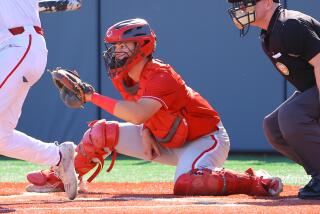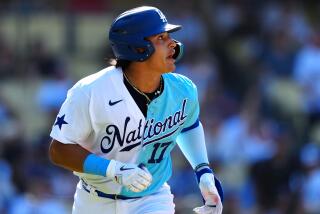Hit and Run : Cory Snyder Makes a Dash Toward Cleveland After Compiling Some Impressive Batting Statistics With Double-A Waterbury
WATERBURY, Conn. â Lettering on the side of the Colonial Bank building in this Southern New England town proclaims: âWaterbury, Itâs the Place to Be.â
Cory Snyder begs to differ.
As property of the Cleveland Indians, he is understandably partial to the Buckeye State.
For Snyder--Olympian, record-setter and three-time All-American at Brigham Young, first-round draft choice and âcanât-missâ prospect--Cleveland, naturally, is the place to be.
At third base in Municipal Stadium, to be exact.
And, besides, Snyder had a hard time getting settled in Waterbury, which he blames on the local citizenry and which he says played a major part in his slow start this season for the Waterbury Indians, Clevelandâs Class AA affiliate in the Eastern League.
âI hate Connecticut with a passion,â Snyder said. âI canât wait to get out of here. Iâll never come back--unless they force me to.â
Itâs not likely that they will.
After an 0-for-22 start, Snyder has struggled for five months to raise his batting average to a season-high .282, but he leads the Eastern League in home runs (27) and runs batted in (92) going into a season-ending doubleheader tonight at Albany, N.Y.
Baseball America, in its âBest Toolsâ poll, named Snyder, 22, the best batting prospect in the Eastern League, based on interviews with the leagueâs managers.
And, despite his team-leading 34 errors, the former Canyon High star was also named the leagueâs best defensive third baseman.
Although the Indians will finish at least seven games behind the league champion Albany Yankees, Snyder is being mentioned as a strong candidate for league player of the year.
âItâs been a good year,â Snyder said over dinner recently. âI canât call it a great year, I canât call it a bad year because itâs my first year. Itâs kind of like a base. Next year, Iâll know exactly what to work for. Within myself, I think I can hit for a higher average. . . .
âNext year, Iâll be able to say, âI did this last year, so Iâm going to work for that.â I want to stay consistent, but I want to get a little better in each category if I can.â
The Indians believe he will.
And in a big way, too.
âWith the kind of tools he has,â said Waterbury Manager Jack Aker, âheâs the type of player who could carry a team in the major leagues once he becomes a polished player. He can be a guy to build an organization around.â
The foundation was laid this season in the Central Naugatuck Valley, some 3,000 miles from his Camarillo home and a few dozen bus rides from the glamour and prestige of the major leagues.
Snyder came here from Tucson, where he opened spring training in the Indiansâ big-league camp.
He had hoped to become one of only a handful of players--among them Sandy Koufax, Al Kaline, Dave Winfield and Bob Horner--to move right into the majors without first serving an apprenticeship in the minors.
It seemed a realistic goal.
At BYU, he had put together a career batting average of .432, set an NCAA record for career slugging percentage (.844) and hit
more home runs (73) than any collegiate player had ever hit in a three-year career.
The Indians made him the No. 4 pick overall in last summerâs draft, then looked on contentedly as Snyder battered opposing pitchers as the starting shortstop for the U.S. Olympic team.
During a pre-Olympic tour, he became the only amateur in history to hit a ball over the roof at Chicagoâs Comiskey Park.
In five games during the Olympics, he hit .400 with two home runs and seven RBIs.
The Indians assigned him to the Southern Division of the Florida Instructional League after the Olympics, and in 46 games he won the leagueâs triple crown with 14 home runs, 53 RBIs and a .390 batting average.
But in his first spring training camp, Snyder struggled.
In 10 games, he batted only .182, with four hits in 22 at-bats.
âI was probably a little up-tight playing against guys you see on TV and read about,â he said. âI gave the pitchers more credit than they deserved.â
The Indians sent him down, they said, to âpolish the rough edges.â
And then his problems really began.
âThings werenât falling for me,â Snyder said. âI started off hitting the ball right at people and then I probably started pressing a little because I really wanted to hit bad. I started maybe getting a little anxious--getting out in front and stuff, instead of just waiting and doing my thing.
âIt wasnât really as bad as it sounds. Even though I didnât get a hit, I was excited. I couldnât wait to get back the next day to try to get that hit. It was like a challenge for me to get my first hit.â
Snyder attributes his poor start, in part, to his unsettled home life. For almost two weeks, he lived in a hotel room, unable to find an apartment. âNobody would rent to us,â he said. When he did find a place to live, it was in a room off an alley in a seedier part of downtown.
âI didnât have any idea where I was going to live, which I think had something to do with the way I was playing,â he said. âItâs good to have a place to go home to at night that is comfortable, where you can just relax and forget about everything. And I didnât have that for a while. . . .
âI wasnât totally relaxed at the place downtown. I was always a little up-tight. I didnât know what was going to happen at night. Going out of town and leaving your stuff there, you never really knew what was going to happen.â
About two months into the season, Snyder finally settled in Middletown, about 30 miles from Waterbury. He bought a beat-up, old station wagon to make the drive.
And at last, he said, he felt comfortable.
He rents the recreation room in the home of Bob and Charlotte Fralick. Fralick, a former scout, is a promotional consultant for the New Britain Red Sox, but he doesnât see a conflict in housing one of his employerâs Eastern League rivals.
âWe donât compare secrets,â Fralick said.
But they talk baseball. In fact, thatâs just about all they talk about.
Fralick guesses that Snyder, whose father coached him in Little League and regularly attended practices at BYU, missed having somebody around to share his experiences.
âOn my birthday,â Fralick said, âhe gave me a card and wrote that I had been just like a father to him. . . . His dad is very, very concerned with Coryâs career and I think Cory missed this talking with somebody. When he talks to me, he wonât cry on my shoulder, but Iâll give him some advice like I would to any ballplayer.â
Almost immediately, Snyder felt at home with the Fralicks, who live in a pleasant, hilly part of town with their 20-year-old daughter and 16-year-old son.
âI could relax and it was safe,â he said.
The improvement in his home life was reflected in his play. Snyderâs batting average has risen steadily all season.
It took him more than a month to reach .200, and at the time of the Eastern League All-Star Game July 15, he was still batting only .236. But in 47 games since, he has batted .367 with 65 hits, 12 home runs and 39 RBIs.
It was only a matter of time before the superlatives followed.
Fralick calls him âfar superiorâ to Wade Boggs of the Boston Red Sox because he has more power and is more skilled defensively. Aker, who managed for eight seasons in the Metsâ organization, said he has seen very few players with Snyderâs ability. He compares him to the Metsâ Darryl Strawberry.
âWe knew it would only be a matter of time before he caught up with everybody else,â said Jim Driscoll, Waterburyâs infield instructor. âAnd heâs since been on the upswing and going by people-- fast. â
Said Aker: âHeâs just scratching the surface of what heâs capable of doing. I think eventually, when heâs in the major leagues, heâs going to be a guy whoâs capable of hitting 40 or 45 home runs a season. . . .
âWhen you have a player with his capabilities, you have to keep playing him until he brings it out. I would have been very surprised if he hadnât come out of it. . . .
âIn a way, it was good that he started out struggling because I think a little humility in everybody is good.â
Dain Syverson, who rooms with Snyder on the road, said Snyderâs slow start may have matured the third baseman.
âHe had a little failure, probably for the first time in his career,â Syverson said. âHe handled it well and got over it. I donât think heâll have any trouble with that if it should happen again.â
When the Indians sent Snyder down, Manager Pat Corrales said: âNext time we see him, heâll be a finished product.â
The product still needs work.
Said Aker: âItâs going to take at least another year, maybe two years, for him to become a major league third baseman--partially because itâs a new position, partially because heâs a big guy (6-4, 190) and heâs got to develop quickness.
âYouâve got to have a quick first step at third base, and he doesnât have that yet. It will take a while before he can do it. His hands, though, are good. He catches what he gets to.â
And, as almost everyone who has seen him play this season is quick to add, he has a great arm.
They say it would have been a waste to make Snyder a second baseman, as the Indians tried to do in spring training.
âHeâs got by far the best throwing arm in the league,â said Albany Manager Barry Foote, âand probably the best throwing arm in baseball for a third baseman. . . .
âHis arm strength is phenomenal. His arm is a seven arm, or an eight arm (on a scale of two to eight). If somebodyâs got a better one, I havenât seen it.â
Driscoll, a former major league player, said Snyder has the best arm of any infielder heâs seen in the last 20 years.
A scout for the Baltimore Orioles before joining the Indians this season, Driscoll used to keep track of Snyder at BYU.
One day, he said, he stood behind first base with a radar gun that scouts use to clock pitches. Snyder, he said, registered at 91 m.p.h. throwing from third base.
âHeâs just got a golden arm,â Driscoll said.
His many errors, the coaches said, are not for any lack of talent, but because of his inexperience.
âHeâs made the normal errors that most young players make,â Aker said. âHe had a lot of multiple errors, where he would bobble the ball and then panic and throw it away. . . . With more experience, heâll cut down those errors to a minimum.â
Said Driscoll: âHeâs got such a great arm and he doesnât utilize it a lot of times like he should. Heâll get a routine ground ball and instead of unloading like he should, heâll take a little bit off and thatâs when he gets in trouble.
âItâs not something that weâre overly concerned about. He had some footwork problems--he was getting his feet tangled up, but weâve since got that straightened out.â
Snyder already thinks of himself as a good defensive player.
âEverybodyâs going to make errors,â he said. âNobodyâs perfect out there. Sometimes you just lose your concentration and you think if a ballâs hit to you, you know what to do with it. But sometimes you just react differently and you stutter a little bit and you try to rush your throw and it goes wild.â
One reason the Indians sent Snyder to Double A was to make sure he played every day and gained a lot of experience, which he has been able to do.
In fact, he is the only player in the Eastern League who hasnât missed a game this season.
The Indians are 73-64 and qualified for the league playoffs, which begin Monday night.
He would have prefered Triple A, Snyder said, âbut as it turned out, I had a good year here and that will keep my confidence up, which is what they were trying to do.â
This fall, Snyder will return to an instructional league.
Heâll marry Tina Bottenfield of Fallbrook, Calif., a former BYU student, on Dec. 6 in Los Angeles and then heâll take some time off before spring training.
Heâd like to be in the majors as soon as possible, of course, but he said he doesnât have a timetable.
âYou just have to go out and do your things and when they think youâre ready, theyâll bring you up,â Snyder said. âItâs up to them--Iâm playing for them. If they think Iâm ready, theyâll bring me up. I just have to keep playing hard and hitting the ball the way I can.
âNext year, if I go to big-league camp, Iâll be ready. Iâm going to give them a run for their money next year.â
He said he is âsmoother and more relaxedâ than he was at the start of the season.
âI donât rush throws in the field,â he said. âIâve gotten better as the seasonâs gone on. I feel like Iâve improved. I feel a lot more comfortable.â
But heâd feel even more comfortable in Cleveland.
More to Read
Go beyond the scoreboard
Get the latest on L.A.'s teams in the daily Sports Report newsletter.
You may occasionally receive promotional content from the Los Angeles Times.










